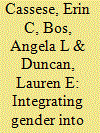| Srl | Item |
| 1 |
ID:
111959


|
|
|
|
|
| Publication |
2012.
|
| Summary/Abstract |
The New Research on Gender in Political Psychology Conference brought together new and experienced teachers with interests in gender politics. The conference session "Teaching Gender throughout the Curriculum" generated a great deal of discussion concerning the pedagogical practice of gender mainstreaming. Gender mainstreaming-the integration of gendered content into courses required for a major-was recognized as one of 11 recommendations for reforming the undergraduate political science curriculum in the 1991 APSA report "Liberal Learning an The Political Science Major: A Report to the Profession" (popularly referred to as the Wahlke Report). Little information is available on the prevalence of gender courses in the undergraduate curriculum, but the data that does exist suggest such courses are uncommon (Brandes et al. 2001). We found virtually no data on the practice of gender mainstreaming in political science and little data in the way of assessing the impact of gendered content when students are exposed to it. This absence of data suggests gender mainstreaming has not emerged as a serious priority for curricular reform.
|
|
|
|
|
|
|
|
|
|
|
|
|
|
|
|
| 2 |
ID:
126423


|
|
|
|
|
| Publication |
2013.
|
| Summary/Abstract |
The Socially Mediated Internet Survey (SMIS) method is a cost-effective technique used to obtain web-based, adult samples for experimental research in political science. SMIS engages central figures in online social networks to help recruit participants among visitors to these websites, yielding sizable samples for experimental research. We present data from six samples collected using the SMIS method and compare them to those gathered by other sampling approaches such as Amazon's Mechanical Turk. While not representative of the general adult population, our SMIS samples are significantly more diverse than undergraduate convenience samples, not only demographically but also politically. We discuss the applicability of the method to experimental research and its usefulness for obtaining samples of special, politically relevant subpopulations such as political sophisticates and activists. We argue that the diversity of SMIS samples, along with the ability to capture highly engaged citizens, can circumvent questions about the artificiality of political behavior experiments entirely based on student samples and help to document sources of heterogeneous experimental treatment effects.
|
|
|
|
|
|
|
|
|
|
|
|
|
|
|
|
| 3 |
ID:
159529


|
|
|
|
|
| Summary/Abstract |
Women are underrepresented among political science faculty and leave academic careers at far greater rates than their male colleagues. Women’s lower research productivity is one reason for the declining number of women in advanced academic ranks. Mentoring can provide necessary advice and feedback to encourage scholarly production, but research shows that female scholars face challenges in traditional mentoring arrangements. We propose that peer mentoring can provide a missing link by supporting research productivity. Using a case study of an existing peer-mentoring group, we document how writing groups can provide flexible mechanisms for peer mentoring that circumvent the obstacles women face with mentoring and complement existing mentoring relationships. We discuss the structure of this group—as well as a survey-based assessment of it—to demonstrate how this approach can be readily adopted by other women in the profession who seek to expand their network of mentors to include peers in their subfield.
|
|
|
|
|
|
|
|
|
|
|
|
|
|
|
|